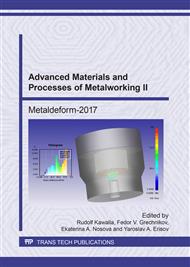[1]
D. Draganovskà, G. Izarikovà, J. Brezinovà, A. Guzanovà, The Study of Parameters of Surface Roughness by the Correlation Analysis, Materials Science Forum. 818 (2015) 15-18.
Google Scholar
[2]
N.L. Parthasarathi, U. Borah, Sh.K. Albert, Correlation between coefficient of friction and surface roughness in dry sliding wear of AISI 316 L (N) stainless steel at elevated temperatures, Computer Modelling and New Technologies. 17 (2013) 51–63.
DOI: 10.1016/j.matdes.2013.04.050
Google Scholar
[3]
A.N. Malov, P.V. Pavlov, Determination of surface roughness parameters of optically opaque parts by speckles using spiral beams, Commuter Optics. 3 (2012).
Google Scholar
[4]
M.D.E. Forbes, What We Talk About When We Talk About Light, American Chemical Societ. 1 (2015) 354−363.
DOI: 10.1021/acscentsci.5b00261
Google Scholar
[5]
J.A. Dieste, A. Fernandez-Cuello, C. Javierre, J. Santolaria, Conformal polishing approach: Tool footprint analysis, Advances in Mechanical Engineering. 8 (2016) 1–14.
DOI: 10.1177/1687814016630518
Google Scholar
[6]
D. Liao, Q. Zhang, R. Xie, X. Chen, S. Zhao, J. Wang, Deterministic measurement and correction of the pad shape in full-aperture polishing processes, J. Eur. Opt. Soc. -Rapid. 10 (2015) 15049.
DOI: 10.2971/jeos.2015.15049
Google Scholar
[7]
Information on http: /mathworld. wolfram. com/SpearmanRankCorrelationCoefficient. html.
Google Scholar
[8]
N.L. Kazanskiy, V.A. Kolpakov, A.I. Kolpakov, Anisotropic Etching of SiO2 in High-Voltage Gas-Discharge Plasmas, Russian Microelectronics. 3 (2004) 169-182.
DOI: 10.1023/b:rumi.0000026175.29416.eb
Google Scholar
[9]
E.A. Bezus, L.L. Doskolovich, N.L. Kazanskiy, Interference pattern formation in evanescent electromagnetic waves using waveguide diffraction gratings, Quantum Electronics. 41 (2011) 759-764.
DOI: 10.1070/qe2011v041n08abeh014500
Google Scholar
[10]
S.R. Abul'khanov, N.L. Kazanskiy, L.L. Doskolovich, O.Y. Kazakova, Manufacture of diffractive optical elements by cutting on numerically controlled machine tools, Russian Engineering Research. 31 (2011) 1268-1272.
DOI: 10.3103/s1068798x11120033
Google Scholar
[11]
N.L. Kazanskiy, S.N. Khonina, R.V. Skidanov, A.A. Morozov, S.I. Kharitonov, S.G. Volotovskiy, Formation of images using multilevel diffractive lens, Computer Optics. 38 (2014) 425-434.
DOI: 10.18287/0134-2452-2014-38-3-425-434
Google Scholar
[12]
N.L. Kazanskiy, O. Yu. Moiseev, S. D. Poletayev, Microprofile Formation by Thermal Oxidation of Molybdenum Films, Technical Physics Letters. 42 (2016) 164-166.
DOI: 10.1134/s1063785016020085
Google Scholar
[13]
N.L. Kazanskiy, I.S. Stepanenko, A.I. Khaimovich, S.V. Kravchenko, E.V. Byzov, M.A. Moiseev, Injectional multilens molding parameters optimization, Computer Optics. 40 (2016) 203-214.
DOI: 10.18287/2412-6179-2016-40-2-203-214
Google Scholar
[14]
S.A. Borodin, A.V. Volkov, N.L. Kazanskiy, Device for analyzing nanoroughness and contamination on a substrate from the dynamic state of a liquid drop deposited on its surface, Journal of Optical Technology. 76 (2009) 408-412.
DOI: 10.1364/jot.76.000408
Google Scholar
[15]
N.L. Kazanskiy, S.P. Murzin, Ye.L. Osetrov, V.I. Tregub, Synthesis of nanoporous structures in metallic materials under laser action, Optics and Lasers in Engineering. 49 (2011) 1264-1267.
DOI: 10.1016/j.optlaseng.2011.07.001
Google Scholar


